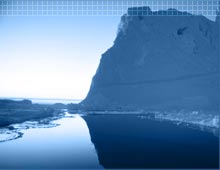
|
 |
 |

January 22, 2003
I Visit a Special Place to Learn About Penguins.
Most research at Palmer Station takes place within about two miles of base. Zodiac
boats are generally prohibited from going any further for fear that bad weather
or something else unexpected might cause a mishap far from help. However, today
I am cruising across 13 miles of open water to the Joubins, an archipelago of
islands that has an almost mythic stature at Palmer Station. Few people ever get
to visit them, though many would like to see their rugged beauty. Bill Fraser,
Donna Patterson, and their birder team, nicknamed the "Schnappers" needed special
permission to go today. They picked a cloudless, still day, the first in two weeks.
I was invited because there's an important story to tell here about penguins.
As Palmer Station recedes toward the horizon, the rocky slopes of Mount William
appear right behind it. Farther back, completely covered in blinding-white snow,
rises the 9,300-foot summit of Mount Fran�ais. We speed through a narrow passage
between Island Eight and a skyscraper-size iceberg (the 126 islands in the Joubins
have no names, so the birders number them for their records) . Seconds later,
a truck-size hunk of ice slips off the berg making a thunderous crash and shattering
into hundreds of chunks. As we land on the shore we watch the iceberg in amazement
and relief; it totters and sheds more huge ice slabs right where our boat just
passed.
The birders have come here to do a census of the penguins and petrels on these
boulder-strewn isles. Fraser has been coming here to survey penguins for almost
30 years. He's discovered a pattern that concerns him. When he first visited here
in 1975, this island had about 300 breeding pairs of Adelies and a handful of
chinstrap and gentoo penguins. Adelies here, as everywhere else near Palmer Station,
have been in a slow decline ever since. Today, there are about 150 pairs of gentoos
on Island Eight making them the most common penguin. Chinstraps are second with
about 30 pairs. Fraser says now there are just 15 Adelies.
Adelies have the classic bird-in-tuxedo look. They are the size of a toy poodle
standing on its hind legs. Chinstraps look similar and are about the same size,
but they have a thin black line in their feathers (it looks like the strap of
a hat) under their chin. Gentoos have an orange bill and white eye patches that
make them look like they are wearing glasses when they bend over. Fraser doesn't
know for sure where the Adelies went or where the gentoos and chinstraps came
from. He has some evidence that the Adelies are simply not producing enough chicks
to replace the adults that die of old age. He says it is unlikely that the Adelies
have moved somewhere else, as he has banded nearly 20,000 Adelies in 30 years
and has yet to find one that has moved away from the immediate Palmer area. They
are extraordinarily attached to the colonies where they are born. However, the
gentoos may be coming from somewhere else north of Palmer, where they have traditionally
nested.
Over the course of a nearly 12-hour day we weave among the Joubins, some no bigger
than a football field. Some have sheer spines of granite, whereas others are flat
and boulder-strewn. The many narrow channels among the cluster of isles are choked
with icebergs large and small. Today the seas are calm and the water is crystal
clear. We visit one island where there are the bones of a beached humpback whale.
Elsewhere, we discover some strange and unusual fossils. I make audio recordings
of the gentoos, which I have not seen before, and a trio of napping leopard seals
snoring. After visiting every Joubin with penguins or petrels, it's time to boat
home. The sun is on the wane. Our return trip is slowed by a thick band of brash
ice coming from an iceberg that must have split in two. Finally we arrive at base.
The cook has saved us a Louisiana dinner of Jambalaya, cat fish, red beans and
rice, and pecan pie.
I'll be writing more about Bill Fraser's research in future journals. The researcher
believes that the changes in the penguin population are due in large part to climate
change. The Antarctic Peninsula has warmed as much as anywhere else in the world
(on average winter temperatures here are nine degrees Fahrenheit warmer today
than they were 50 years ago). I'll explain later why he thinks change is bad news
for Adelies, but good for chinstraps and gentoos. If Fraser is right, the Antarctic
could be an early indication of what might occur in other parts of the world as
Earth's temperature continues to climb. "We're seeing a system changing before
our eyes in ways that ecologist speculated 30 years ago things might change in
response to climate warming," says the scientist.
Read the January 17th entry
Read the January 14th entry
Read the January 13th entry
Read the January 9th entry
Read the December 29th entry
Read the December 23rd entry
|
|



